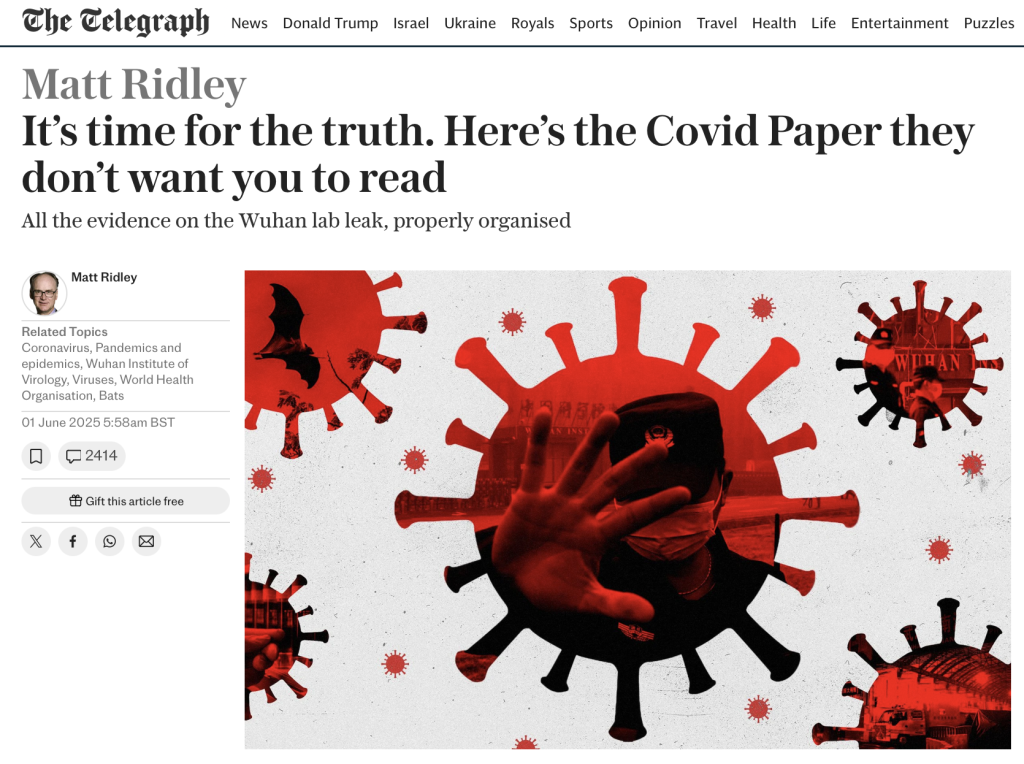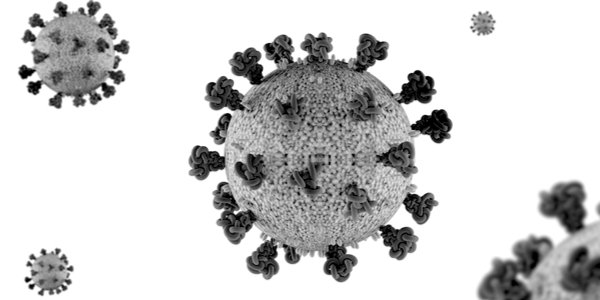ON JUNE 1, the Daily Telegraph published the following article by Matt Ridley:

(An archived version accessible to non-subscribers can be found here.)
This preface introduced an academic paper written by Lord Ridley and Professor Anton van der Merwe of the University of Oxford.
Before addressing some of the paper’s language and claims, it’s worth noting the irony of one of the UK’s most influential news organisations – whose Global Health coverage is partially funded by the Bill & Melinda Gates Foundation – declaring: ‘Here’s the Covid Paper they don’t want you to read’. If ‘they’ truly didn’t want it to be read, would it be featured in a mass-media outlet? (Not likely.)
The paper itself advances the following narrative:
- A novel virus emerged suddenly in Wuhan ‘some time in the last four months of 2019’ causing the first human case of a new disease eventually called Covid-19 and an ‘outbreak’ of illness and death that wasn’t ‘caught’ and contained in time.
- This was the result of a ‘lab leak’ which ‘Big Science’ has been ignoring or downplaying.
- Said virus circumnavigated the globe from a point source and was directly responsible for tens of millions of deaths and widespread suffering throughout the world.
These assumptions buckle under scrutiny and render the notion that ‘the Covid-19 pandemic began as a result of a research accident’ both misleading and unsubstantiated. Indeed, readily available evidence shows a pandemic ‘began’ only when a political declaration was made, not with an empirically observable or remarkable biological phenomenon that required a response of any kind. Until the point of the pandemic declaration there was never a solid epidemiological or medical basis for alleging the existence of a pathogenic threat to the world, and only after the response was declared did mortality rise.
The SARS-CoV-2 story ‘began’ in late December 2019, with Chinese health alerts evocative of a Medical Mystery Theatre prologue: There’s a cluster of pneumonia cases of unknown etiology in Wuhan . . .
This was followed by a speedy succession of events in a four-week span that included:
- claims of unique symptoms;
- ostensible discovery of a ‘new’ causal agent;
- development of a reliable test to ‘detect’ the agent;
- alleged ‘confirmation’ of the agent transmitting from human to human;
- speculation about possible sources of the agent (eg a market, a lab, a cave);
- the WHO declaring a Public Health Emergency of International Concern (PHEIC).
However, through our own investigations and the analyses of others, we have found substantial direct evidence culled from hundreds of research papers, official reports and from analyses of official statistics from multiple countries:
- the purportedly unique fingerprint that shows the agent to be both synthetic, and hence more dangerous, than competing natural viruses, is contradicted by published research and by known hard limits to what is currently possible in biology;
- a causal relationship between the agent and a new or dangerous type of pneumonia or disease was never demonstrated;
- the novelty, integrity, and stability of the agent remains unproven;
- the newly invented tests, used to diagnose current or prior infection by the agent, were not specific to that agent but instead cross-reacted with other viruses, including those causing the common cold and influenza-like illnesses;
- studies and reports fail to substantiate transmission claims;
- time-series mortality data and ‘on-the-ground’ evidence, culled from official statistics, are at odds with what would be expected in the event of a novel, dangerous, spreading disease consistent with a ‘pandemic’.
Based on his own writings, and by his own admission in the Telegraph article, Ridley has always viewed the origins question by entertaining and exploring only two options: the agent either leaked from a lab or by way of a discrete zoonotic event in a wet market. We regard this framing as unscientific as it has the effect of limiting other possibilities, stymying genuine inquiry, and bypassing what we have come to understand is the far more important question:
Is the sudden emergence of a novel SARS-like virus causative of a new disease, spreading from human to human, as initially claimed by the WHO and CCP, the most likely explanation for the events which have come to be known as ‘the Covid pandemic’?
A significant problem with Ridley and van der Merwe’s argument is that they (by their own admission) present only circumstantial evidence for a ‘lab leak’. They completely fail to examine any research which might (and indeed does) contradict their hypothesis nor do they assess whether the observable consequences of their hypothesis are consistent with the idea of a pandemic, which they assume as axiomatic.
Likewise, they deliberately frame the hypotheses as a false binary choice between two mutually exclusive alternatives: lab-leak or wet-market. This framing explicitly excludes two rather obvious alternative explanations: one being that there never was a new virus, and another that this virus was already endemic globally, perhaps for decades, but was simply novel to detection. If anything, their myopic focus on a single hypothesis reflects nothing more than an ex-cathedra belief that such a leak could and did trigger a local epidemic and, subsequently, a global pandemic.
Emails showing disagreement and faction-forming between scientists, lack of co-operation from China, individuals acting to protect themselves and their interests, hubristic grant proposals, cave-scouring activities, fibs about research funding, grandiose theoretical models, reported activities in laboratories, safety protocol breaches, a few lab workers getting sick after working with chemicals, secrecy surrounding database deletions – none of these things is scientific evidence of a transmissible pathogen departing a lab via a worker or any other means. Feynman said science is the distrust of experts, yet Ridley/van der Merwe simply accept the collective word of these ‘experts’ at face value and fail to subject it to even modest scrutiny.
The authors seem aware that their evidence is limited and non-conclusive, conceding that their ‘facts amount to a strong though circumstantial case for suspecting that a laboratory leak started the pandemic’. In other words, facts amassed over five years haven’t produced a hypothesis developed beyond conjecture – only a response to a single question framed as a false dilemma.
The Ridley/van der Merwe hypothesis also places an undue emphasis on the attributes of ‘the sequence’ which came to be named SARS-CoV-2. If the core claims – that a novel pathogen suddenly spread, triggered waves of illness, and caused deaths that would not (absent doing anything ‘in response’) have otherwise occurred – don’t hold up, then the speedy (and specious) output of a suite of relatively new and imperfectly understood sequencing technologies is surely the wrong starting point.
Science favours the most parsimonious hypothesis that successfully survives serious attempts to falsify it using all relevant available evidence. And, by Occam’s razor, competing hypotheses that are overly complex and which can rely only on cherry-picked data, or prejudicial assumptions contradicted by the evidence, are rejected.
The simplest hypothesis – that no novel pathogen emerged in 2019/20, whether from Wuhan or elsewhere, and that any apparent novelty was merely an illusion driven by technology and propaganda – therefore remains the default; after five years of ‘searches,’ no body of evidence has been assembled to supplant it.
Hence, we place the burden on Lord Ridley and Professor van der Merwe to account for and address the holes in their hypothesis and show how the mass of evidence we have collected does not falsify their claims:
- How did the entity named SARS-CoV-2 get from a lab in Wuhan to other places? How long did the journey take? By what routes did it ‘travel’ (if it ‘travelled’)?
- When did SARS-CoV-2 begin to affect humans in a unique way (i.e. differentiable from other influenza-like-illnesses or colds)? In what research papers, data or qualitative evidence should we have seen this and when did these unique symptoms first start to appear?
- Why did SARS-CoV-2 first appear in some places with higher incidence than it did in others? What accounts for the synchronous ‘arrivals’ between geographically disparate places?
- How was it possible for SARS-CoV-2 to be ‘spreading’ without having any impact on all-cause or respiratory disease death levels until after officials in a country declared an emergency and launched mass testing?
- Why did it appear to ‘hit hard’ or ‘explode’ in some cities but not others, even where the cities have similar characteristics?
More specific to the alleged starting point:
- Doesn’t the absence of infected animals and animal traders at the Wuhan market – and no early ‘cases’ being affiliated with any other market in Wuhan – present a serious challenge to the ‘lab leak’ view as well? If a highly infectious and transmissible SARS virus escaped in early fall 2019, then how did it avoid animals at the Wuhan market, as well as people who had been at other markets and densely populated places?
- Likewise, if the agent is so infectious and transmissible, then why did the clusters appear only in Wuhan and not in other provinces? If the answer is because China is hiding information about illness reports and the ‘true’ start of the epidemic, then what reason is there to trust anything else that Chinese officials, doctors, and scientists claimed? Is there any evidence of clusters of unusual illness elsewhere in China prior to December 2019?
- Finally, why is there a marked absence of clusters of unusual illness in nearly every country before the explosion in ‘cases’ coincident with the institution of mass testing? Wouldn’t the (purported) spread of something so contagious and deadly – which resulted in such cases being so widely geographically dispersed – have been bound to manifest in surveillance reports or in some other way?
Matt Ridley is concerned about a lack of interest in the ‘origins of covid’. We share those concerns, whilst obviously disagreeing with his central premise. In the spirit of scientific inquiry, we would be delighted if the authors could engage with us by answering our questions. If they are correct, a robust, well-reasoned response can serve only to strengthen their claims.











